Festivals and Cultural Celebrations Around the World:
A Look at Various Cultural Festivals
Festivals and cultural celebrations are an essential part of the cultural heritage of peoples around the world. These celebrations reflect the traditions and history of societies and contribute to strengthening collective identity and celebrating shared beliefs and values. Here is a look at some different cultural festivals and their associated traditions and rituals:
01. Eid al-Adha – Islamic Countries

Millions of Muslims across the globe — including in countries like India, Indonesia, Turkey, Russia and Pakistan — celebrating Eid al-Adha, Islam’s most revered observance.
Known as the Feast of Sacrifice or “big Eid,” it is one of the two major religious festivals of Islam. The other, Eid al-Fitr, occurs at the end of Ramadan, the holy month of fasting.

Eid al-Adha commemorates the Koranic tale of the Prophet Abraham’s willingness to sacrifice his son Ishmael as an act of obedience to God. Before he could carry out the sacrifice, God provided a ram as an offering.
Muslims celebrate the Adha by slaughtering domestic animals like sheep and distributing the meat to the poor, as a symbol of Abraham’s willingness to sacrifice his only son.
Traditions and Rituals:

- Prayer: The day begins with Eid prayer in mosques.
- Sacrifice: Animals (sheep, cow, or camel) are sacrificed, and the meat is distributed among family, friends, and the poor.
- Family Gathering: Families and friends gather to share meals and exchange greetings.
02. Carnival – Brazil

Carnival is an annual Catholic festival that occurs leading up to Lent. Like Mardi Gras and other Carnivals worldwide, it’s a big celebration of the food and pleasures one must give up during Lent. In Brazil, the Carnival is a really big deal, and the people plan the festivities months in advance.
Because the celebrations happen during February and March, during Brazil’s summer, the ambiance is perfect for massive parties. There is even a common saying in Brazil that “the year starts only after Carnival,” referring to the number of people that take their holidays between New Year’s and Carnival, which itself is a national holiday.
Traditions and Rituals:

- Dances and Parades: The carnival is famous for its colorful dance performances and samba parades.
- Costumes: Participants wear vibrant and decorated costumes with feathers and jewels.
- Music: Traditional Brazilian music adds a festive atmosphere to the streets.
03. Diwali – India

Diwali, or Dipawali, is India’s biggest and most important holiday of the year. The festival gets its name from the row (avali) of clay lamps (deepa) that Indians light outside their homes to symbolize the inner light that protects from spiritual darkness. This festival is as important to Hindus as the Christmas holiday is to Christians.

People pray, enjoy festive meals and light fireworks; sweets are distributed among neighbours and friends and a feeling of joy permeates the air.
Traditions and Rituals:

- Lights: Homes and streets are lit with lights and lanterns, symbolizing the victory of light over darkness.
- Worship: Hindus perform worship in temples and offer sacrifices.
- Fireworks: Fireworks are an important part of the celebrations.
04. Christmas – Western Countries

Christmas is a Christian holiday. Christians mark the birth of Jesus Christ who, according to the Christian religion, was the Son of God sent to Earth to save humanity. Hence the name of the holiday: Christ-mas. The way the holiday is celebrated has also been influenced by some older, long-gone religions.

Christmas is therefore only celebrated by countries where Christianity has historically been the majority religion or by Christian minorities around the world. In countries where Christianity has historically been the dominant religion, a lot of non-religious people still celebrate it.
Traditions and Rituals:

- Decorations: Homes are decorated with Christmas trees and ornaments.
- Gifts: Exchanging gifts among family and friends.
- Food: Preparing feasts and enjoying traditional foods like turkey.
5. Halloween – United States and Western Countries

Halloween is one of the oldest festivals of mankind. Evil spirits and supernatural beings were involved in the Celtic festival of Samhain (translation: Summer’s End), which was celebrated at the end of the harvest season, respectively, the beginning of the new year, on October 31st. For the Celts, it was a magical time during which the gate to the realm of spirits was open, and ghosts, elves, demons, and other supernatural beings walked the earth. On Samhain, the Celtic druids held large bonfires to get in touch with them.

Holidays like Halloween are celebrated by several countries across the world mostly in some parts of the counties in Europe, and western countries like the United States and Canada. This is a belief that makes people look for various costumes and also by watching horror shows.
The costumes are worn by different characters, where some characters are usually seen in movies or some from the ancient historical stories of a country.
Traditions and Rituals:

- Costumes: Children and adults wear costumes.
- Carved Pumpkins: Carving pumpkins and placing candles inside them.
- Trick-or-Treating: Children go door-to-door for candy.
6. Chinese New Year – China

Chinese New Year, also known as the Spring Festival, is a time of great celebration in China, characterized by lively traditions and family gatherings.
Lunar New Year is one of the most important celebrations of the year among East and Southeast Asian cultures, including Chinese, Vietnamese and Korean communities, among others. The New Year celebration is celebrated for multiple days—not just one day as in the Gregorian calendar’s New Year.

Tied to the lunar calendar, the holiday began as a time for feasting and to honor household and heavenly deities, as well as ancestors. The New Year typically begins with the first new moon that occurs between the end of January and spans the first 15 days of the first month of the lunar calendar—until the full moon arrives.
Traditions and Rituals:

- Fireworks: Launching fireworks to ward off evil spirits.
- Family Dinner: Families gather for a special dinner on New Year’s Eve.
- Gifts: Exchanging red envelopes containing money.
The Importance of Cultural Festivals
Cultural festivals and celebrations help strengthen social bonds and celebrate cultural identity. They provide an opportunity to express joy and celebrate shared beliefs and values. These events form part of collective memory and enhance the sense of belonging to the community.













Leave a comment